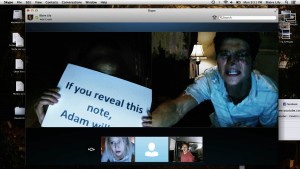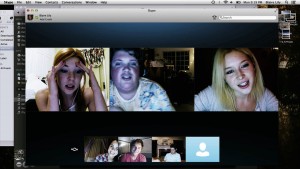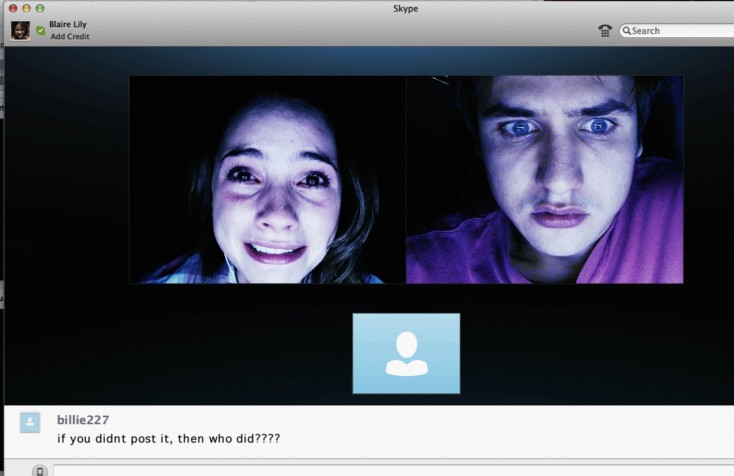
Jess (RENEE OLSTEAD) and Mitch (MOSES STORM) stare in terror as Adam (WILL PELTZ, top) screams in terror in Universal Pictures’ ©Universal Studios.
By ANGELA DAWSON
Front Row Features
HOLLYWOOD—Fifteen years ago, the “found footage” storytelling technique used in “The Blair Witch Project” changed the way many horror movies were made.
The next evolution in the genre may be one started by Russian filmmaker Timur Bekmambetov (“Night Watch,” “Day Watch,” “Wanted”), who had an idea for a new kind of storytelling in which the plot unfolds entirely on a computer screen.
The first feature length film in which that technique is used is the R-rated horror flick “Unfriended,” in which a group of high school classmates are terrorized by a stranger while chatting with each other on the Internet. The deadly intruder knows more dark secrets about each of these teens than they know about each other, giving new meaning to the phrase ghost in the machine.
Bekmambetov got the idea about 10 years ago but it wasn’t until he pitched it to Nelson Greaves, his assistant at the time, that it was used to tell a horror story. Greaves wrote a draft and in a few weeks delivered it to his boss. After securing financing, Bekmambetov called his friend and colleague Levan Gabriadze (“Lucky Trouble”) to direct the film. Together with Bekmambetov, they cast it with young up-and-coming actors and then shot it over the period of a week in a house in northern Los Angeles.
Shelley Hennig, who starred in the recently released “Ouija” and TV series “The Secret Circle,” heads a cast that includes Moses Storm (NBC’s “About a Boy”), Renee Olstead, (The Secret Life of the American Teenager”), Will Peltz (“Men, Women & Children”), Jacob Wysocki (“Huge”), Courtney Halverson (“Godspeed”) and Heather Sossaman (“Beverly Hills 90210”).

Clockwise, top left) Val (COURTNEY HALVERSON), Ken (JACOB WYSOCKI), Jess (RENEE OLSTEAD), Adam (WILL PELTZ), Mitch (MOSES STORM) and Blaire (SHELLEY HENNIG) in Universal Pictures’ “UNFRIENDED.” ©Universal Studios.
The story begins with a high school girl who has been driven to suicide after being recorded in an embarrassing position at a party and then seeing it posted online for the world to humiliate her. Later, a friendly late night online chat among half a dozen of the deceased girl’s friends devolves into an indictment of their actions when an uninvited stranger joins the conversation.
After completing production on “Unfriended,” (an action used by Facebook members to remove unwanted “Friends” from seeing their account), the filmmakers partnered with Universal Pictures and Blumhouse Productions (the production company behind the highly successful “Paranormal Activity,” “The Purge” and “Insidious” horror franchises.
At a recent press day, Greaves and Blum (executive producer and CEO of Blumhouse Productions) spoke about using the groundbreaking framing device in which the movie screen is filled with computer screen imagery and actions.
Q: This is an R-rated film. Do you worry that kids who should be getting the anti-cyberbully message will miss it because they’re not old enough to see the film?
Blum: We make a lot of scary movies. Some of them have messages and some of them don’t. Like “The Purge” is really a message about the lack of gun control, and this one is about cyberbullying. But I don’t think people are going to a movie for a message. That’s really secondary to making a great scary movie, and if it happens to have a message, all the better. I don’t think you can think about the message first.
If it weren’t rated R, it wouldn’t feel real so then no one would get the message because then no one would come and see it.
Q: Nelson, as the writer on this, did it challenge you to come up with material that would be compelling without the use of exterior locations?
Greaves: Very much so. I approached this like I was writing a play. And I understood that it was going to be shown in real time, and there were going to be characters alone in their rooms together, and it was going to be exactly like a play, and it would have the same logic questions and challenges that were going to come up and we were going to be tackling and looking at. At the same time, we also have the same benefits of a play, which is you don’t think about anything else. It’s just the characters; it’s just the world. If you can get audiences to buy into that then you can have something that is a lot more dramatic than throwing chainsaws or whatever you want to throw in. You don’t that human connection that we establish in the film.
Blum: I wasn’t around when the movie was made. We got involved later. When they made the movie, they shot it from beginning to end like a play for two hours.
Greaves: We shot it like that as well. We were in a house and we turned each room of the house into a kid’s bedroom. Basically, Adam Sidman, who’s a co-producer, and was also one of the first people to come onboard the project, designed this system for us where they could all see each other, hear each other and hear us as well. The actors were each alone in their room for 85 minutes. We would do takes that were the entire length of the film and they would come out of their room afterwards. I remember Shelley after the longest take, and the one that ends the movie. Her eyes were puffy and she looked dazed. We were like, “What just happened? What did we just capture?” It’s not something you can get when you’re making a normal movie.
Q: Do you feel like you’re ushering in a new era of horror films?
Blum: It’s a little early for that.
Greaves: All we set out to do with “Unfriended,” and all I hope that we achieved, is that we told a story about the way people live that other people haven’t been telling. Some of us spend up to 12 hours a day in front of a computer. That’s most of our lives, and yet there aren’t stories on screen telling those things. The way I look at it, we weren’t setting out to tell a digital horror story. We weren’t setting out to tell a story about digital relationships. We set out to tell a story about the way people live now. Facebook friendships are just friendships. Email is just communication between family, between people. That’s all we set out to do. That’s all we hoped to do.
Q: Do you expect more film to launch a horror franchise?
Blum: Yeah, it’s kind of like how “Blair Witch” started with the found footage and then “Paranormal Activity” took it to the next place, and then after that there were a lot of found footage movies. But it never took over, there were never more than 2-3 percent of movies that were found footage, and I feel like we’re always going to see, at least in the near future, most movies will be traditionally shot. But I feel like there will be found footage (style) movies every so often and hopefully there will be more movies like this. (To Greaves) I don’t know what we’re calling it. Do we have a name for this?
Greaves: Screencast movies.
Blum: There will be found footage and screencast as tools at a director’s disposal to tell the story that he or she wants to tell.
Q: Have you had to unfriend someone on Facebook?
Blum: I’m not on Facebook anymore but I have unfriended people.
Greaves: I have unfriended exes but not out of a desire to be cruel. Only out of a need to move on. That’s what I told myself, at least.
Q: What was the length of the shoot?
Greaves: Initial photography was seven days, followed by two days of pickups. Over the course of the next year and a half, there were probably five more days of photography. But it was fairly quick. On the first day of photography, we’d shot the entire film. Because of the format, it was really about trial and error. Trying new things and after that and seeing how we could push things to the next level.
Q: Was it easy to get Facebook and Google onboard?
Blum: Officially, no comment. Unofficially, our job was to make the movie great and real. It would not have been had we not had that authenticity to it.
Q: What kind of cameras did you use to get the webcam look?
Greaves: We used Go-Pros and then we treated the footage pretty extensively in editorial.
Q: Did the casting come together quickly?
Greaves: Unbelievably quickly. John McAlary did our casting. He cast it in just a little over two weeks. And we had several parts speak for every role. There was no luck involved; it was him being amazing.
Q: The audition involved the actors speaking directly into a camera, right?
Greaves: It didn’t start out that way. We did it the conventional way but then we realized that didn’t tell us anything. So, we changed it and they sat in the room next door, and we sat on Skype next door. And we did the auditions that way. We were able to record them as well that way. For callbacks, we called them back as groups and we did group chats together. This was where we could see if they could do what we needed them to do. Our movie is bizarre in that you have all six leads up on the screen with their faces in close up the entire length of the film, which is unlike any other film. If any one of them weren’t great, the movie wouldn’t work. They all had to be great and they are.





